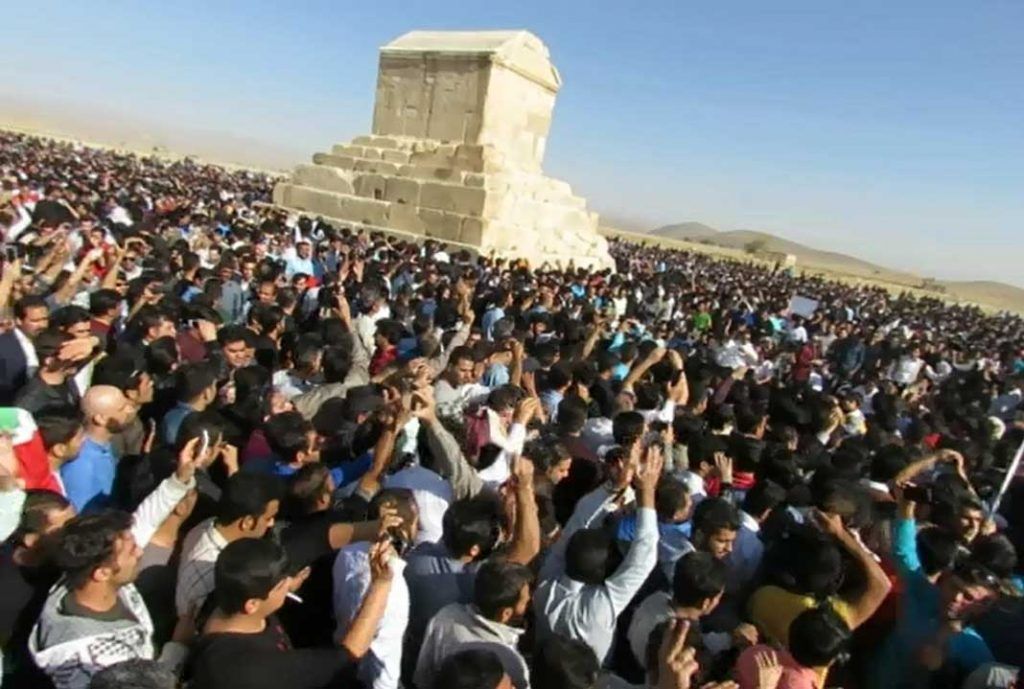November 07, 2016
A record number of people gathered at Pasargad this year, even though state run media did not publicise the event. Surprisingly, government and security forces did not interfere with this year’s gathering. Reportedly some participants objected to what they perceived as “racist” slogans chanted by the crowd.

Although Ministry of Tourism prohibited travel agencies from scheduling any tours of Pasargad from mid to late October, many families travelled with their own cars. It is estimated that over one million visitors passed through the site from early morning hours of 29 October until midnight.
One participant said: “most people are from middle class families and have travelled here in a show of solidarity. It is a peaceful and orderly gathering.”
The authorities neither interrupted nor tried to stop the event. A number of prominent artists and entertainers also took part in the event, including Mohammad Reza Ali Payam (a.k.a Haloo) and Ahmad Baran Monjeri. They were arrested and held for a few hours. The regime had not anticipated the large turnout and the authorities were not prepared to deal with the consequences of cracking down on the massive crowd.
Controversial Chants
The slogan “We are Aryans not Arabs” chanted by a number of participants was deemed as racist by some attendees. When viewed within a larger context and alongside other chants including “Iran is our land and Cyrus is our father,” “Clerical rule is ignorant and oppressive,” “Let’s protect our homeland and heritage before we lose them both,” “Long live Cyrus, long live Iran” and “Long live Iranian Arabs, Azeris and Kurds,” the slogan appears nationalistic in nature. Some believe that the regime has labeled the crowd at Pasargad racist in order to deflect attention from domestic problems, and create a rift within the Iranian society.
Many Iranians view the Islamic republic as a pro Arabic regime, which has systematically tried to denigrate the Iranian culture and replace it with Arabic ideology. The regime hails the role and influence of Islam in shaping Iran and demeans the pre Islamic history of the country. Ali Larijani, speaker of the Majlis (Iranian parliament), has described the pre islamic Iran as “barbaric,” suggesting that the Iranian civilisation has been shaped by Arabic and Islamic ideology.
Prominent scholars have argued that Iranian culture changed and moulded the thinking of its conquerors and even “Persianised” Islam. As such, most slogans chanted at Pasargad, including “Neither Gaza, nor Lebanon, I die for Iran” and “They say it is God’s will, but Arabs are responsible for the ills,” were meant to target the ideology and policies of the Islamic republic.
Save Pasargad Institute designated October 29 as the International Day of Cyrus the Great, in commemoration of the Achaemenid king who founded and ruled the Persian Empire for 30 years until his death in 530 BC. The occasion, however, is not marked in any national or international calendar.
Iranians have been visiting the Achaemenid king’s tomb in Pasargad, located in the vicinity of the southern city of Shiraz on 29 October for a number of years. The significant increase in participation in the event in recent years is attributed to the sharing of information on the internet and social media despite attempts by the regime to block communication regarding the event.
Significance of 29 October
October 29 is not Cyrus’ date of birth. It marks the day the king entered Babylon and famously issued his decree which has been hailed as the first charter of human rights. The decree states, “… I entered Babylon in peace, amidst joy and jubilation…My massive army paraded about Babylon in peace…I did not allow any trouble in all of Sumer and Akkad. I took great care in protecting the city of Babylon and its places of worship…I liberated the citizens of Babylon and released them from their sufferings… I restored ancient sanctuaries…I also returned people to their homes…”

At a time when empires where built on violence, bloodshed and expansionism and the ruling elites subjugated the masses, the benevolent Achaemenid ruler promoted religious freedom and human rights for all those living in his kingdom. He made the welfare of his subjects his priority. He has been revered and held in high regard by other civilisations, and has even been praised in the Torah. The Cyrus Charter has secured a prominent place for “the king of kings” in history.
A Gathering without Government’s Support
The Pasargad event neither receives financial support from the regime nor is it covered by the state-run media. According to one of the movement’s founders, the annual gathering was originally organised in the mid 1990s by a group of culturally minded citizens who were alarmed by the regime’s disregard for the country’s national heritage.
In 2005 when the plan for the construction of Sivand Dam in Fars province threatened to flood parts of the ancient ruins of Persepolis, including Cyrus’ tomb, activists drew the world’s attention to a potential crisis.
On 29 October of that year, many NGOs, including Mehraein Cultural Institute of Khuzestan, Iranian Cultural Association (Partition) of Tehran, Free Swallows Centre of Tehran, Open Culture Centre of Greater Iran, and Kaveh the Blacksmith Institution of Hamedan, joined the effort to rescue and preserve the site. Iranians have welcomed calls by many international organisations including UNESCO and “Save Pasargad” to rescue the historic site.
The aim of the Pasargad annual event is to commemorate Cyrus the Great, celebrate Iranian heritage, and reclaim cultural identity. It is wrong to accuse those who celebrate the legacy of Cyrus, the champion of human rights and religious freedom, as racist.
[responsivevoice_button voice=”US English Female” buttontext=”Listen to this “]

